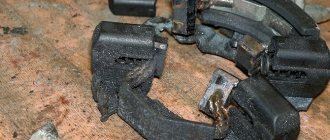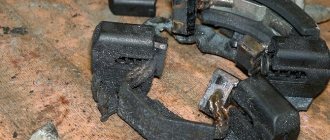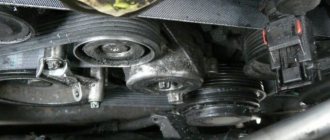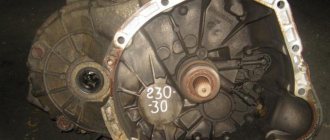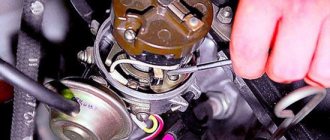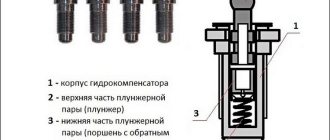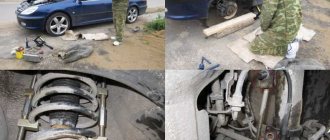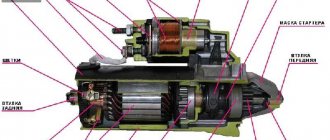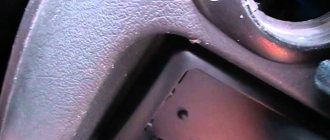To begin with, it should be noted that on cars such as the VAZ-2107, the manufacturer can install starters of various types. Essentially, they perform the same function, but may differ slightly from each other in terms of design. Also note that the starter is a special mechanism that generates direct current, while creating the torque necessary for the crankshaft to start rotating.
Assessing the scale of the problem
If, when you turn the key in the ignition switch, the starter does not turn, no clicks or sounds are heard, then the reason may be this:
- the battery is discharged or faulty;
- battery contacts are oxidized;
- problem with the contacts of the starter itself;
- a break in the windings of the device or the electrical circuit of the car.
When the starter turns slowly, clicks of the traction relay are heard, the reason may be this:
- there is a charge in the battery, but it is not enough to properly spin the moving parts of the starter;
- carbon deposits have formed on the contacts or they have oxidized;
- worn brushes or burnt commutator;
- short circuits in windings or brush holders.
Starter brush wear
Repeated operation of the relay and its spontaneous shutdown can be caused by a voltage drop in the network due to oxidized contacts or a malfunction of the traction relay. When the starter turns, but the flywheel does not rotate, there may be several reasons:
- problem with the freewheel (Bendix);
- drive or flywheel teeth are damaged;
- The bearings or springs of the traction relay are worn out.
These are perhaps the main malfunctions and their most common explanations. They are equally valid for carburetor models and injectors.
Diagnostics of faults in the VAZ 07 model starter
- no rotor rotation;
- clicks when trying to start;
- extraneous sounds when the device is operating.
Starter won't start
The electric motor does not work due to battery discharge or winding failure. When the battery is discharged, the lighting devices do not turn on or the lamps glow dimly, and when you try to start the engine, a click is heard, after which the indicators go out.
Crackling sound when starting the starter
A cracking sound indicates a breakdown of the solenoid relay, which cannot engage the rotor gear with the flywheel ring. The repair consists of checking the wiring and measuring the resistance of the windings. A damaged relay must be replaced.
The starter clicks but does not turn over
The defect indicates insufficient voltage in the power supply due to battery discharge or oxidation of the contact pads. When the battery is low, the clicking sound is accompanied by a decrease in the brightness of the lamps. The defect is observed when there is poor contact between the battery contacts and the wiring terminals.
The starter hums but the engine does not start
The reason for the hum is that the bendix is jammed; the relay cannot move the gear to the flywheel. To check it is necessary to remove the electric motor. After cleaning the starter from dirt, performance is restored.
The starter turns the crankshaft with difficulty, as if the battery is dead
With this malfunction, the starter may work “every other time”; in warm weather, the car starts normally. But even in the mildest frost, problems begin: it is with great difficulty that the engine cranks, and the load on the battery is enormous (can be seen on the voltmeter). There may be two reasons - wear of the bushings and the armature touching the stator. The second is interturn short circuits and other damage to the armature winding. In both cases, the starter begins to “slow down” itself. Most often, such a starter is replaced entirely, since repairs can be more expensive.
What is a VAZ 2107 starter and how to change it?
A faulty VAZ 2107 starter causes the engine to simply stop starting.
When the key is turned in the ignition switch, the electrical circuit is closed, but the starter itself does not fire, so no force is transmitted to the crankshaft and it simply does not turn.
There can be many reasons why this happens, ranging from a banal short circuit in the car’s electrical system, to failure of the starter rotor winding or mechanical wear of the brushes. How to properly disassemble and repair a VAZ 2107 starter?
Starter device for a VAZ 2107 car
The design of the VAZ 2107 starter is to some extent reminiscent of an ordinary electric motor. The basis of the design is the so-called shoe, which is driven by the rotor.
t, in turn, begins to rotate when a voltage of 12 V is applied to it. This is the so-called gear starter. An ordinary electromagnet, which consists of an insulated copper winding, a metal core and brushes, is responsible for generating the magnetic field.
On the VAZ 21074 car, a similar scheme is used, but a slightly different fastening is used - 3 bolts each. The brushes transmit voltage to the rotor. They wear out not only due to friction, but also due to the high current generated by the coil.
The starter switching relay, located with it in a single housing, is responsible for the supply of electricity and timely shutdown of the shoe.
The operating principle of the classic starter on the VAZ 2107 is extremely simple: the device is connected to the crankshaft. When voltage is applied to the rotor, it spins and turns the fists.
As a result, the engine starts, after which power is supplied to the spark plugs from the generator, and not from the battery.
During an emergency engine start, a similar scheme is used - artificial cranking of the crankshaft.
It is not always the case that the engine does not start due to a faulty starter. It is possible that the problem lies in the wiring. Therefore, the first step is to study the starter connection diagram and all underwater wiring for a break. If one is found, the area will have to be replaced. At the same time, it is advisable to check the operation of the fuse (it is located on the left side of the hood).
It should also be mentioned that in some starter models protection is installed - this is an additional relay that automatically turns off the traction and prevents the supply of electricity from the battery even when the engine is running. These were not included in the factory configuration, but many install them after a certain period of operation.
Starter components
To repair a part of any device, you need to understand what it consists of. So, for example, the design of the starter is as follows:
- anchor;
- frame;
- drive unit;
- relay. Connection to it is made using contact bolts, which are considered structural elements. Each of them consists of parts that are fairly easy to replace if necessary.
Remember that it is quite easy to repair the starter on a VAZ-2107 with your own hands. To do this, you need to know what exactly it consists of, as well as what it is intended for.
Work order
- We place the car on a viewing hole or overpass and secure it with the parking brake.
- Open the hood and disconnect the ground wire from the battery.
- Using a 10mm socket, unscrew the bolt of the lower fastening of the starter heat shield.
- We dismantle the air filter housing and the warm air supply hose (for injection units, remove the fastenings of the intake pipeline).
- Using a socket wrench with a 13 mm extension, unscrew the 3 bolts securing the starter housing. It is better to unscrew the bottom bolt from the inspection hole.
- Using a 13mm wrench, unscrew the nut (on the injection engine there are two nuts) securing the starter shield. Let's take it out.
- Using a socket wrench with a 13 mm extension, unscrew the 3 bolts securing the starter housing. It is better to unscrew the bottom bolt from the inspection hole.
- Using the same tool, unscrew the nut securing the tip of the wire going to the “+” battery.
- Disconnect the start relay wire.
- We remove the starter from the rear wall of the engine compartment.
- We install a new starter in its place.
- We carry out installation work in reverse order.
What to do first?
Disassembling the mechanism is not a priority task, since the starter’s power supply is connected to the battery, so you need to start with it. If the car is not too old, it is unlikely that the problems will lie in the design of the starter itself. It is enough to clean the contacts of the battery or the device itself for everything to work again in the desired mode.
Difficulties begin when the machine has worked for a long time and its operation has not been delicate. If, after a complete check of the electrical equipment of your VAZ 2107, the starter still does not start or continues to work intermittently, then the reason is inside the device and it is necessary to remove and disassemble the starter. On this model, both in carburetor and injection versions, it is installed rather inconveniently. To get to it normally, you will have to drive the car onto an overpass or inspection hole.
Disassembling the VAZ 2107 starter
After the ignition is turned off, you can begin the “operation”. It must be done in the following order:
- remove the ground terminal from the battery;
- if there is a protective mud casing at the bottom, then it must be dismantled;
- remove the electrical wires from the solenoid relay;
- unscrew the three mounting bolts (two upper, one lower);
- remove the starter.
As you can see, nothing complicated. The only thing is that in the case of an injection model, mechanics advise removing the inlet pipe extensions as well. Now we have to disassemble the device itself.
How to check the starter for performance?
Before repairing the device, it is necessary to diagnose it. This will allow you to determine the type of malfunction and the procedure for doing the repair yourself. There are two options for checking the starter - with or without removal.
Checking the starter without removing it
To diagnose the operation of the starter device without dismantling, you will need a metal product. It will be used to close the contact terminals at the output of the mechanism. As a metal object, you can use a piece of electrical cable or a screwdriver with a bare shaft.
If there is sparking, but there is no cranking of the starter device, do the following:
- The contact terminals on the battery are being diagnosed; you need to make sure that there is no oxidation on the terminals. If there is white or other color deposits, cleaning is done using sandpaper. If it is not available, you can use a knife, but you must act carefully.
- The operation of the solenoid relay is checked. The unit should be disassembled and the device replaced if necessary.
- The integrity of the electrical circuit between the solenoid relay of the device and the mechanism itself is diagnosed. The assembly will also have to be disassembled. The cause may be damaged wiring.
The starter assembly rotates the crankshaft, but the rotation is not sufficient to start the engine:
- You need to check the battery charge and replenish it if necessary. If recharging is not possible, it is permissible to “light” the car from a vehicle with a charged battery.
- It is necessary to diagnose the integrity of the power cables connected to the starter mechanism. There may be an insulation break or breakdown.
When the key is turned in the lock slot, the crankshaft does not turn, but the device clicks:
- Low battery. Requires recharging.
- The contacts are damaged or their quality is poor. We are talking about contact elements connected to the starter unit. It is necessary to check the integrity of the parts and tighten them if necessary.
If the steps described above did not help, you need to check the operation of the traction relay. The problem may also be with the ignition switch. If the diagnostics did not determine the cause, the switch will need to be disassembled and checked. To make sure that the lock is not working properly, you need to thoroughly clean all contacts and connections.
User Battery Man showed how you can check the current of the starter device on a mechanism that has not been removed from the car.
Checking the starter with removal
After removal, the starter mechanism must be securely fixed in a vice. This should be done carefully so as not to damage the device. Then you need to connect battery power to it and use a screwdriver or a piece of cable to close the contact screws. If the mechanism begins to spin, then the problem lies in the operation of the retractor relay.
Further diagnostics:
- To ensure that the traction relay is working, the positive terminal from the battery is connected to it. The negative contact is connected to the mechanism body. If this element is working, then the anchor device will extend the gear. You may not see this, but you will hear a characteristic click.
- Then the integrity of the brush mechanism and armature is checked, for this purpose a 12-volt voltage is supplied to the unit. To check the operation of the anchor device, take a 220-volt household lamp and connect it to the break point between the winding and the pulley. If, as a result of connection, the light source begins to burn or sparks appear, then the anchor element must be replaced. When sparking, you can smell a burning smell.
- To diagnose the brush assembly, a 12 volt lamp is used. The device is connected to the brush assembly or mechanism body. If, as a result of connection, the light source begins to burn, then the brushes must be replaced.
- Bendix diagnostics are being performed. To do this, place a soft pad around the part and clamp it in a vice. It is necessary to check the quality of functioning of the coupling itself. If, as a result of physical impact, it turns in different directions, then the bendix must be replaced. The clutch should only turn in one direction.
When diagnosing the starter on a VAZ-2107, you must remember that most malfunctions are caused by problems with electrical circuits, as well as the battery or solenoid relay.
How to properly dismantle the starter?
To remove the device, proceed as follows:
- The car is placed in a garage with a pit or on an overpass. The handbrake lever is raised to prevent the vehicle from rolling away.
- The engine compartment is opened and the ground wire is disconnected from the battery. The terminal clamp must be loosened with a wrench in advance.
- Using a 10mm socket wrench, unscrew the screws that secure the heat shield of the starter mechanism.
- The air filter device is removed, then its housing is dismantled. You also need to turn off the air flow supply pipe.
- Using a 13mm socket wrench, unscrew the nut that secures the starter shield. Then this element is dismantled.
- Using the same 13 key, the three screws that secure the starter mechanism housing are unscrewed. The key will be required with an extension cord. It will be more convenient to unscrew the lowest screw from under the bottom, from the hole.
- A wrench is used to unscrew the nut that secures the tip of the cable connected to the positive terminal of the battery.
- The cable with the contact connected to the start relay is disconnected.
- The starter mechanism is being dismantled. When removing, you must act from the rear wall of the engine compartment.
The Dvigatel channel talked about dismantling the starter device on VAZ-2107 cars.
If the car has an injection engine
When performing work on a vehicle equipped with a fuel-injected internal combustion engine, it is necessary to dismantle the intake manifold extension. It connects directly to the power unit. Also, on injection engines, instead of one nut that secures the starter mechanism shield, two are used.
If the car has a carburetor engine
The main feature of dismantling work on carburetor internal combustion engines is the need to remove the air filter housing. Without this, it will not be possible to remove the knot.
Detailed installation process
In order to correctly install the starter, you must adhere to the following points:
1. Conduct a visual inspection of the device. 2. Installation of the device in its original place. First fasten with a long bolt, and then with two short ones. 3. Install the wire terminals and tighten the nuts. 4. Replace the battery. 5. Connect the terminals on the battery. 6. Install the braces coming from the intake pipe or air duct and air filter. 7. Replace the mudguard (if equipped).
After everything is done, you should start the engine. If everything works as expected, then the starter connection is made correctly. If the engine does not start, you should look for where the error was made.
Dismantling process
Removing the starter on a VAZ 2107 begins with the fact that you need to detect it. This point concerns beginners, because experienced drivers know where the starter is located. Located near the bottom of the power unit. It will not be possible to remove it while on the ground. You need to drive the car either into a pit or onto an overpass. In fact, awkward placement is the biggest problem in the removal and installation process. Otherwise, everything is very simple and convenient.
The actual dismantling process is as follows:
1. First of all, you need to remove the battery terminals. 2. Some 7 models have a mudguard, it is installed under the engine. It needs to be dismantled. 3. Remove the battery. 4. Unscrew the clamp of the wiring harness going to the starter. 5. Remove the wires from the traction relay. 6. Remove the stretch marks that come from the inlet pipeline. 7. The starter itself is removed.
The dismantling process is completed, and now you can take the starter for repairs, or replace it with a new one.
The above describes the process that is performed on cars with an injection power system. Do not forget that there are VAZ 2107 models with a carburetor installed. In such cars, the dismantling process has minor differences. The carburetor model does not have an intake pipe or stretch marks from it. This means you need to do this:
— Remove the wires from the traction relay. — Remove the air duct and the air filter. — Remove the starter.
Actually, the difference from the injector is only in one point, as you can see. As for the malfunctions that may occur, most often drivers are faced with the fact that the starter does not turn. In this case, it is better to install a new one, but you can send the old one for repairs, in the hope that a good repairman will come across who can fix everything.
Starter performance check and repair
First of all, you should clean the starter housing from dirt, which inevitably accumulates on it during the operation of the car. Then connect the mechanism to the battery: the “negative” wire to the starter housing, the “positive” wire to the contact of the traction relay. A characteristic click should follow, and a drive gear will appear in the front “cutout” of the casing. Now use an ohmmeter and check the armature windings for opens and shorts. To do this, you need to open the cover at the back of the starter and remove the brush holders with brushes.
Then connect the ohmmeter with one end to the armature body, and the other - alternately to the sectors of the winding. If there are no short circuits or breaks, the instrument needle will fluctuate from a minimum value of 10 kOhm and above.
Now comes the integrity check of the stator winding (in other words, located inside the housing, along the walls of the cylinder). Here you simply connect the ohmmeter contacts to the copper wire terminals. The arrow of the measuring device should “lie” in the area of the highest value if there are no problems. If there are breaks or short circuits in the windings of the starter or solenoid relay, there is no point in bothering with repairs if you have never dealt with electromechanics and have not encountered the technology of manufacturing electric coils. It is best (and easier) to purchase a complete starter and install a new starter.
Checking the integrity of the stator winding
An operation that can really be called a repair is replacing brushes. You can easily find out that they are erased during diagnostics. It is enough to turn the starter on its side when it is connected to the battery and turns properly. If the unit immediately stalls, brush wear is to blame. Replacing parts is simple and accessible even to a beginner. It was already mentioned above that it is enough to remove the cover at the rear of the starter. When the brush holder is removed, the springs in it will themselves push out the brushes, which will hang on the wires. Replacement is a matter of minutes.
The main thing is to never allow oil or fuel to come into contact with brushes or wire windings. Electrics do not tolerate moisture or grease. Therefore, during any operations with starter parts, especially when assembling it, act carefully and, if possible, stay away from liquids and fuels and lubricants.
There is one rare malfunction when the starter turns on, but nothing turns. In this case, the bendix is to blame - a device that prevents the teeth of the drive gear from sharply hitting the flywheel. Its main malfunctions are wear of the rollers, the gear itself, weakening of the pressure spring or unsuitability of the lubricant. This part is inexpensive, changes quickly, and therefore there is no point in bothering with repairs. It is better to purchase it in a store; replacement is done on the “return” when the starter is being assembled.
Sometimes the armature bushings need to be replaced, but this is extremely rare because they are made of very reliable material and wear only appears after a really long period of use. There are only two of them - in the toe and back cover. The process of knocking the bushings out of their seats is usually confusing, but by choosing the right attachment, you won’t ruin anything. Next, a part of the required diameter is lubricated and pushed into the hole. If things get tight, don’t use more force; it’s better to sand the bushing body and try again, otherwise the socket may simply burst.
- “They moved my car onto the lawn, and it turned out to be my fault” - the story of a motorist who suffered because of utility workers
- 6 Mercedes that were officially imported to the USSR
- 4 ways to deceive drivers in tire shops
- 4 mistakes when transporting cargo on the roof of a car that can lead to serious damage
- Advice from psychologists: how not to look at a traffic police inspector to avoid problems
- Celebrities who collect cars
- I found out why people buy used oil - you need to be careful
- “I was charged money for an accident in Volgograd, although I did not have an accident and had never been to this city,” is the story of our subscriber
Causes of malfunction
Any part can fail. But it’s not enough to just do it. We also need to find out what caused the malfunction and prevent it from happening again. After all, the reason may not be in the part itself, but for example, the fault may be hidden in a circuit that is located even before it. Let's think about the reasons for the malfunction. There may be several of them:
- One of the reasons may be wear on the commutator brushes and their loose fit. In this case, check how freely they move in the brush holder. The price of a new brush is low; drivers often prefer to simply replace them.
- Often the cause of a starter malfunction lies in the relay : the winding burns out or the contacts burn out. Sometimes corrosion of the anchor causes it to jam. In the case when, when starting the engine, the starter rotates along with the flywheel, the relay is also at fault. These malfunctions are most typical for the starter solenoid relay - repairing a VAZ 2107 is rarely complete without replacing it.
- If the starter turns the engine, but very slowly, the generator is most likely to blame. Its diagnostics are carried out on a stand, where the voltage, which should not exceed 14.5V, and the generator turn-on current are determined. Be sure to check the tension of the drive belt. If it slips, the generator cannot develop full power, which inevitably drains the battery.
- The most common breakdown occurs: there is a break in the circuit supplying power to the relay winding. Then you need to check the connection of the wires, tighten the bolts that secure the wire going to ground and check the starter control connector, the so-called 50 pin. The connector may need to be replaced.
Advice! In case of a problem with the contact, crimp the wire with a round copper tip and, together with the fastener, screw the ground to the relay. This will be the simplest solution to this problem.
After making sure that both the relay and the ignition switch are in order, when repairing the VAZ 2107, the starter is carefully examined. To do this, you need to remove it and perform a visual inspection of the contacts on the solenoid relay. Sometimes the cause of poor contact is loosely tightened nuts. In this case, the terminals heat up and burn. How to determine the working capacity of the solenoid relay?
Advice! It’s easier to do this this way: take a piece of wire with a cross-section of 8-10mm2 and connect it to the positive terminal. Place the starter on the battery, resting its body against the negative terminal. Touch the other end of the wire to the terminal on the solenoid relay.
Attention: If after such manipulation the starter starts working, then the cause of the problem is in the relay. If there is no reaction, we can assume that the problem lies in the brushes.
There is one more problem for all cars, not just the VAZ 2107: the starter, which needs to be repaired, has excessive energy consumption. This may be indicated by a strong decrease in instrument panel lighting and lamp brightness. There are three possible problems that may arise here:
- Insufficient wire contact
- Increased mechanical resistance
- Low resistance.
Advice! If cleaning the external contacts of the electrical circuit does not help eliminate the breakdown, you need to check the contacts inside the starter, as well as the brush units.
There are also mechanical reasons that prevent the smooth operation of the starter:
Wear of the bushings promotes short circuits between the windings and jams the moving elements.
- Resistance of the crankshaft due to an error in the selection of bearings or incorrectly filled, too viscous engine oil.
- Break in the armature winding. This defect contributes to sparking at the collector. The electric arc that forms at the rupture site is capable of burning through steel, not just insulation. You can see similar videos on the Internet. In case of desoldering the winding, you only need emery, solder, and a soldering iron.
Diagnosing starter problems
After removal, it is necessary to very carefully clean the starter from any dirt adhering to it to prevent it from penetrating inside the housing. Then we begin diagnostic work. First you need to make sure that the traction relay is working properly, for which we carry out the following actions:
- connect the positive terminal of the battery to the starter output, and the negative terminal to its housing;
- apply a voltage of 50 volts;
- If at the same time the gear of the part (the Bendix, designed to engage with the flywheel and spin it to the required speed) moves out of the housing with a characteristic click, we continue the diagnosis. Otherwise, replace the traction relay.
Where does the repair begin?
All work starts somewhere. And this one is no exception. First, you need to understand what is wrong and only then think about what can be done and how to fix the problem.
Troubleshooting.
To correctly determine, you first need to think and see what the cause of the problem may be:
- If, after turning the key in the ignition, the engine does not start, check the lights on the display. Extinguished or weakly burning and fading light bulbs indicate a malfunction in the battery: it is discharged, or the terminals are not tightened properly. Every driver has a tester in his car that allows him to check the voltage and capacity of the battery without removing it.
- If the battery has nothing to do with it, you need to check the position of the speed switch and, if necessary, put it in the “P” position.
- Next, you need to find out whether power even reaches the starter from the ignition switch?
Advice! The easiest way to do this is on the red wire connector connecting the starter and the unloading relay.
This work can be done in two ways:
- Method 1: - take a copper wire with a cross-section of 2.5 mm2 and insert it into an open connector. One end to the battery terminal and the other to the starter. In this way, ignition is simulated.
- Method 2: - here you need two people: one turns the key in the ignition switch, and the second uses a control probe to touch the tip of the wire coming from the unloading relay. If the warning light comes on, it means there is no damage to the ignition switch or the relay.
Preparation for repair and dismantling of the device
It is more convenient to carry out work in a specially equipped room - a garage box. The VAZ 2107 is installed above the inspection hole; for repair and restoration operations, a set of wrenches, a set of heads with a wrench and a device for pressing out the bearing are required. In the event of a malfunction of several other components in addition to the bendix, it makes sense to replace the starter assembly. On a car where there is an injector in the power supply system, repair work is best carried out from below.
The procedure for dismantling the starter on a VAZ 2107 car is as follows:
- Disconnect the battery and remove it from the engine compartment.
- We unscrew the terminal and disconnect the terminal and the wire that supplies power to the starter.
- We unscrew the bolts securing the device that ensures engine starting.
- We remove the unit complete with the bendix feed mechanism from the hole in the housing.
On a VAZ 2107 car, an engine with an injector installed will require a number of additional operations. In this case, replacing the faulty unit is only possible from below. To gain access to the assembly, you need to remove the steel protection and boots covering the engine compartment from below. The remaining operations carried out on the starter are carried out similarly to those described.
Preliminary work
We install wheel chocks
Performing a few simple steps related to preparing the VAZ 2107 for repair work will significantly save your time, improve the quality of maintenance and will guarantee the safety of your health.
- The place where the machine will be serviced must have good and uniform lighting. In some cases, this can only be achieved through the use of additional lighting.
- Due to the fact that the starter in the VAZ 2107 is located in the lower part of the engine, work on its dismantling should be carried out on an overpass or inspection hole. It is not possible to remove the starter from the top.
The machine must be securely secured using the parking brake or wheel chocks. Otherwise, there is a possibility that the vehicle will start moving spontaneously.
Mechanism repair and installation
After removing the starter from the car, we disassemble it and inspect the components. Particular attention is paid to the condition of the bendix and sliding bearing bushings; the housing must be disassembled for inspection. Carefully remove the brushes from their sockets and clean the commutator of dirt. We assemble the device and check its functionality using the battery.
Installation of the VAZ 2107 engine starting mechanism is carried out in the reverse order of removal. If during testing it is revealed that the starter cannot be restored, it is replaced with a new one. If an injector is installed on the car, after connecting the battery, it will take some time to create the necessary pressure in the gas line. The engine should be started only after the pump has stopped running.
Starter repair
It is quite clear that not every repair of a car’s electrical equipment, and in particular the starter, can be done by yourself. To do this, you will need to ring the winding, this will be necessary in order to correctly determine the fault. If you still decide to repair the starter yourself, you should find out how to properly remove and disassemble the VAZ 2107 starter. Having installed your car on an overpass or inspection hole, you need to disconnect the wire from the negative terminal of the battery. Further actions will depend on what type of engine your car has - carburetor or injection.
Source
How to replace the starter on a VAZ 2101-VAZ 2107?
Note! Before you start replacing this unit, be sure to make sure that its performance is not due to other reasons, for example, the battery is discharged, or its terminals are oxidized, or the wiring that goes to the starter is not working properly!
And also take into account the fact that the starter must be replaced in an inspection ditch, otherwise it will be inconvenient and very problematic to remove from the car!
Removal: 1) First, loosen the clamp that secures the warm air supply hose to the air filter housing.
2) Then loosen the clamp that secures the hose to the air intake itself.
3) And then remove this hose from the car engine.
4) Next, loosen the lower nut that secures the air intake.
5) Next, unscrew the top nut that secures the same air intake.
6) And then remove this air intake from the car engine.
7) Now remove both nuts that secure the heat shield to the engine.
 And then, using an extension joint with the socket head, unscrew the remaining bolt that secures the heat-insulating shield to the right engine mount bracket. (For information on how to unscrew the remaining bolt that secures the heat-insulating shield to the bracket, see the very bottom of the article in the “For Beginners!” section)
And then, using an extension joint with the socket head, unscrew the remaining bolt that secures the heat-insulating shield to the right engine mount bracket. (For information on how to unscrew the remaining bolt that secures the heat-insulating shield to the bracket, see the very bottom of the article in the “For Beginners!” section)
9) After unscrewing the bolt, remove the heat insulation shield from the engine.
10) Next, unscrew the bottom bolt that secures the starter.
11) Then unscrew the remaining two upper bolts, which also secure the starter.
12) Moving the starter a little forward... (Continued in point 13)
13) Disconnect the wire block from the starter traction relay terminal on the starter.
14) Then unscrew the nut that secures the wire to the upper contact of the traction relay.
15) And then disconnect the wire from the upper contact, and also remove the bolt and nut that held this contact.
16) Next, remove the starter from the car engine.
Installation: 1) Installation of a new starter is carried out in the reverse order of removal.
Important! 1) Before starting work, disconnect the negative terminal from the battery! (For information on how to disconnect this terminal, see the article: “About the battery”)
For newbies! Question: How to unscrew the bolt securing the heat-insulating shield to the bracket of the right engine mount. Answer: Using an extension joint with the socket head “2”, unscrew the bolt “1” securing the heat-insulating shield to the bracket of the right engine mount.
Additional video: To understand in more detail how to replace the starter, watch an interesting video in which the replacement process will be described in detail:
Replacing the battery on all VAZ cars
Replacing the gearbox on a VAZ 2101-VAZ 2107
Video
Details about the features of replacing the starter:
Hello, dear car enthusiasts! Especially hello, all owners of the VAZ “Seven”! Because this is exactly what we will be talking about – the VAZ 2107.
Although, the domestic auto industry has nothing special to boast about, given the model line and quality of cars produced, but still, there are examples of cars that should be paid attention to.
VAZ 2107 is a car that can deservedly be called a people's car. Thanks to its somewhat unusual design, this car stands out noticeably from the series of “classic” VAZ cars.
This fact, supplemented by minor design differences, was the reason why the model lasted quite a long time on the assembly line. At times it seemed that the “seven” would be produced forever, but time takes its toll.
Nevertheless, hundreds of thousands of cars of the seventh model are moving on the country’s roads, which will lead the popularity ratings among the “classics” for a very long time.
The design of the VAZ 2107 car is not fundamentally different from previous models. The biggest innovation in recent years has been the installation of an injection power system instead of the usual carburetor.
The rest is classic. This also applies to the starting system. That is why for every car enthusiast who bought a VAZ 2107, how to remove the starter remains a pressing question.
Removing the VAZ 2107 starter in the garage, do it yourself
As in most other cars, in the “seven” the starter is located at the bottom of the engine. In order to get to it, you need to have an inspection hole or overpass, since it cannot be removed through the top.
The inconvenient location is the only difficulty when dismantling the starter. Otherwise, everything is extremely simple; no special tools or special knowledge are required.
Removing the VAZ 2107 starter occurs only with the ignition off as follows:
- First, remove the battery cover and disconnect the ground terminal;
- the mudguard is removed, if one was installed in the lower part of the engine compartment;
- For convenience, the battery and support can be removed;
- the clamp of the wiring harness leading to the starter is unscrewed;
- unscrew and remove the wires from the starter traction relay;
- the three starter mounting bolts are unscrewed (two at the top and one at the bottom), after which the starter is removed under the car.
Reasons for starter failure on a VAZ 2101 and ways to solve problems
- Reasons for starter failure on a VAZ 2101 and ways to solve problems1
- Original parts and their analogues: which is better2
- Procedure for replacing and installing starter3
If one day you got behind the wheel of your car and could not start it, most likely the problem is that the starter does not turn. There can be many reasons for this “behavior”. The problem does not always lie in the device itself:
- low battery charge;
- poor contact at the junction of power wires.
It is important to note that in order for the starter bendix to rotate, a voltage of at least 11.0 V is required. If the battery cannot maintain this value at the moment of starting, then the car simply will not start. As a result, it’s simply not possible to go anywhere. If the engine does not start, then first of all you need to check the presence of voltage at the battery terminals.
If it is normal, you need to make sure that it is present on the incoming wires. This can be done using a multimeter. If there is voltage and there is no break, the problem may be in the electrical part of the starter:
- the solenoid relay does not work;
- The carbon brushes have failed.
You can check the relay without removing the starter itself. It will be enough just to close the contacts directly. This can be done using a screwdriver or insulated wiring with exposed contacts. After closing the contacts, the relay must click - this indicates its operation. If there are no such sounds, then the relay has simply failed. There is no point in repairing it; you just need to replace it.
Another common problem is that the carbon brushes have failed and the stator winding has short circuited. But these faults can only be determined after removing the starter from the car. As well as mechanical failures:
- Bendix failed;
- bearings are worn out;
- The starter fork is broken.
The main working mechanism of the starter is the bendix. It connects the engine flywheel and the starter shaft - which allows torque to be transmitted. The bendix itself is a shaft with a gear at the end. It is its splines that engage. Over time they wear out. The situation can only be resolved by replacing the Bendix.
Bearing wear is also a common problem. You can check their condition without removing them. It is enough to try to rotate the shaft with the starter removed. If it rotates with force or is completely jammed, then the bearings definitely need to be changed. The starter shaft must rotate freely, without applying any force.
During prolonged intensive use of the car, the fork often fails. Figuring out where this component is located is not difficult. You need to remove the starter and disassemble it. This will allow you to determine all the problems that exist in it, what problems there are. In some cases, you will even need a special sdend.
Reasons for replacing brushes
Symptoms, one of the causes of which are worn brushes:
- The starter does not respond when the key is turned to the On position. When warping, freezing or wear occurs, there is no tight fit of the brushes to the armature plates, so the transmitted voltage is not enough to rotate the armature. To check, it is enough to directly close the output of the solenoid relay, on which there is a constant + from the battery, and the contact going directly to the starter housing. If the starter reacted and began to rotate vigorously, then the problem of lack of response to turning the key is not in the brushes;
- The starter rotates the engine flywheel, but does so slowly.
For accurate diagnostics, at the time of checking, the battery must be fully charged, and there must be no parasitic resistance at the contacts of the starter circuit (oxides on the battery terminals, rust, oxides at the point of power supply to the starter, loose terminals, etc.).
Dismantling
In many ways, the subtleties of the process of dismantling the starter will be determined by the peculiarities of the location of the attachments on the engine. You can find out where the starter is located and how to remove it in the repair and maintenance manual for your car.
Regardless of the location and model of the car, dismantling the starter begins with removing the negative terminal of the battery. This way you will be guaranteed to protect yourself from a short circuit when unscrewing the terminals and removing the starter protection.
Disassembly
Since the design of gear starting devices with permanent magnets on different cars is very similar, the process of disassembling the VAZ starter described below and shown in the video can be called universal.
- Disconnect the terminal that goes from the retractor to the starter housing. Even before disassembly, we recommend checking the amount of play in the drive shaft (no. 15 in the figure). If there is large play, replacement of bronze or copper-graphite bushings is required.
- Remove the 2 tie rod bolts (#20) that secure the starter rear cover and two housing pieces. Disconnect the front part, which houses the gearbox, bypass clutch and gear that meshes with the flywheel ring. There is no need to touch the screws on the back cover! They secure the brush assembly to the back cover.
- Remove the planetary gear cover (No. 17). Behind the cover there will be a spacer washer that eliminates axial play of the electric motor. Don't lose it under any circumstances!
- Remove the brush assembly and back cover from the housing on which the permanent magnets will be attached.
- Unscrew the screws securing the brush assembly to the back cover.
- Remove the rear armature retaining ring (No. 21). The design may also include a sealing washer that prevents axial play of the shaft. Some design options may contain a paper gasket, which must be installed back during assembly.
- Remove the old brush assembly.
